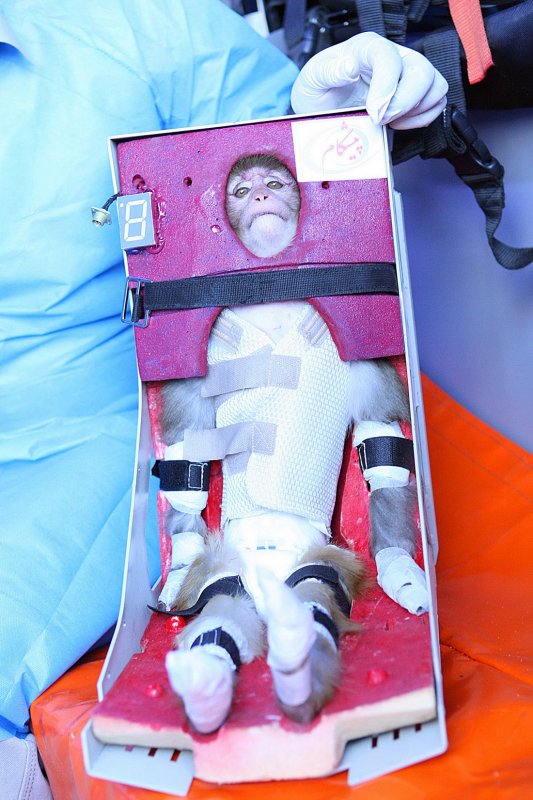1 of 3 | An Iranian scientist holds a live monkey at an unknown location in Iran on January 28, 2013. Iranian state media reported that it lauched the monkey in a suborbital flight and returned it safely to Earth. The missile launch touched concerns that Iran could use this accomplishment to launch nuclear missiles, but there has been no immediately confirmation of Iran's claim. UPI |
License Photo
DUBAI, United Arab Emirates, Jan. 29 (UPI) -- Iran's claim to have lofted a monkey into space atop a Kavoshgar rocket as a step toward a manned space program is making headlines but Western experts worry it's really part of Tehran's quest for more powerful ballistic missiles.
The Iranians are reported by some analysts to have made "robust strides in developing ballistic missiles" of late, but is likely to be "many years away" from developing an intermediate-range solid-propellant missile with a range of 2,500-3,200 miles.
To a large extent, putting a monkey briefly into space was seen as a propaganda operation with few, if any, military applications, possibly to demonstrate Iranian defiance as Western sanctions to force it to abandon its nuclear program bite ever deeper.
Iran's state television said the flight to an altitude of 75 miles by a Pishgam, or Pioneer, space capsule aft atop a Kavoshgar-3 rocket launched by the Aerospace Industries Organization was a prelude to putting an Iranian astronaut in space by 2020, a target Tehran announced several years ago.
But the program to develop a powerful booster rocket to achieve that objective involves technology that is vital for developing a multi-stage, long-range ballistic missile.
Iran's missile program has suffered several serious setbacks in the last three or four years, some attributable to the international sanctions first imposed in mid-2010.
In November 2011, Gen. Hassan Tehrani Moghaddam of the Revolutionary Guards Corps, who was considered to be the mastermind behind the missile program, was killed in series of explosions at a Guards Corps missile base 30 miles west of Tehran.
The Iranians said the blast was accidental and destroyed several ballistic missiles but there has been persistent speculation that the explosions were the work of saboteurs working for either U.S. or Israeli intelligence.
In July 2012, the International Institute for Strategic Studies in London reported that development of Iran's most advanced ballistic missile, the two-stage Sejjil-2, had been stalled because of the sanctions.
Indeed, the think tank said the sanctions, which have made it difficult for Tehran to obtain components and high-tech equipment for the program, "could yet deal a knockout blow to the country's development of long-range missiles."
The 21.5-ton, solid-fuel Sejjil-2, developed by the Air and Space Department of the Ministry of Defense, has an estimated range of 1,375 miles, enough to reach Israel. Unveiled in 2008, it will eventually replace the older, liquid-fuel Shehab-3b missiles that make up Iran's strategic missile command.
Western missile specialists say Iran has as many as 400 of these ballistic weapons deployed.
Uzi Rubin, former director of Israel's Ballistic Missile Defense Organization, said the Sejjil-2 "demonstrates a significant leap in Iran's missile capabilities" that places the Islamic Republic "in the realm of multiple-stage missiles which means they're on their way to having intercontinental ballistic missiles."
The IISS cited "mounting evidence" that if sanctions continue "Iranian attempts to develop and field long-range ballistic missiles could be significantly impeded, if not halted altogether."
Sporadic talks between Iran and the U.S.-led Western powers have failed to make any progress toward a diplomatic settlement that could end the sanctions. The last negotiations took place in June. Western powers had suggested talks in February but Tehran's rejected that. So there's no indication of any early lifting of the sanctions.
In February 2009, Iran made a major technological breakthrough in its drive to build ICBMs with the launch of Omid-1, a scientific research satellite developed by the Iranian Space Agency, atop a Safir-2 booster rocket, a version of the Shehab.
Unlike putting a monkey in space, that launch into orbit from the Semnan Space Research center 180 miles southeast of Tehran was, as Jane's Defense Weekly put it at the time, "a quantum leap in Iran's ballistic missile capability."
As with the Soviet Union's launch of Sputnik, the world's first satellite, in 1957, Rubin stressed: "the world should not be alarmed by the satellite, but by the missile carrying it.
"The Iranians, long students of North Korean missile technology, have now surpassed their tutors: the Safir-2 is the basis for a future Iranian intercontinental ballistic missile."
U.S. missile expert Peter J. Browne explains that "many of the technological building blocks involved in the satellite launch vehicles are the same as those required to develop long-range ballistic missiles."















